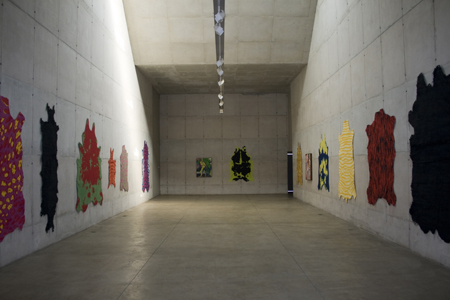“On the outside / grows the furside / on the inside / grows the skinside / so the furside / is the outside / and the skinside / is the inside / oneside likes the / skinside inside / and the furside / on the outside / others like the / skinside outside / and the furside / on the inside / if you turn the / skinside inside / thinking you will / side with that / side then the / softside fursides / inside which / some argue is / the wrong side / if you turn the / furside outside / as you say it / grows on that side / then your outsides / next to skinside / which becomforts / not the right side” Scott Walker.
In his new project, specially developed to be presented at Galeria Leme, Portuguese artist João Pedro Vale presents skins of imaginary animals made of colored napkins and 03 plasticine paintings that make reference to the Brazilian Modernism. In all of these pieces, the artist uses the idea of exotic as a matter of identity and socio-cultural belonging.
According to João Pedro Vale, the idea of skin has various meanings. The most important one, however, is the idea of the skin as a form of cataloguing and differentiating human species, as well as discussing miscegenation and its importance in Brazilian culture.
The paintings exposed in Galeria Leme emphasize, in different ways, the issue of skin color. They are free interpretations of “Antropofagia”, by Tarsila do Amaral, “O homem de sete cores”, by Anita Malfatti, and “Cinco Moças de Guaratinguetá”, by Di Cavalcanti, all emblematic paintings from the Brazilian Modernism. Such free interpretations have a complementary, yet complex, relationship with the paper skins, as they orientate and, at the same time, provoke the spectator.
Themes such as national identity and the possible mechanisms responsible for the construction of this idea have always been present in João Pedro Vale’s work. The artist uses Portugal’s historic episodes and Portuguese mythologies to discuss the ways in witch governments may manipulate these facts and ideas in their convenience. Developing projects that explore the relationship between Portugal and Brazil was something inevitable.
In “Bonfim”, realized in 2005 and presented at Estação Pinacoteca, São Paulo, the idea of journey and cultural exchange was brought to light. In “Misericórdia”, also realized in 2005, the artist discussed the trade relations between the Crown and the Colony with an ironic tone. The artist’s first participation in Galeria Leme may be also included among these pieces. “Foi bonita a festa, pá”, a wooden boat with carnations and beer bottles from Portuguese brand Sagres all over it, works as an allusion to the dictatorships governments to witch both countries were undergone.
